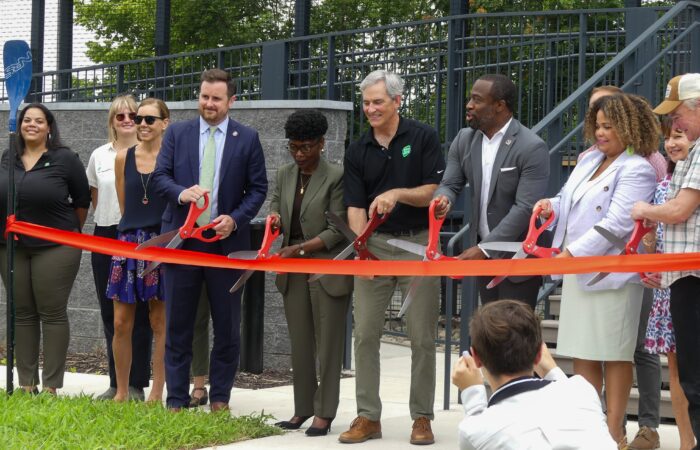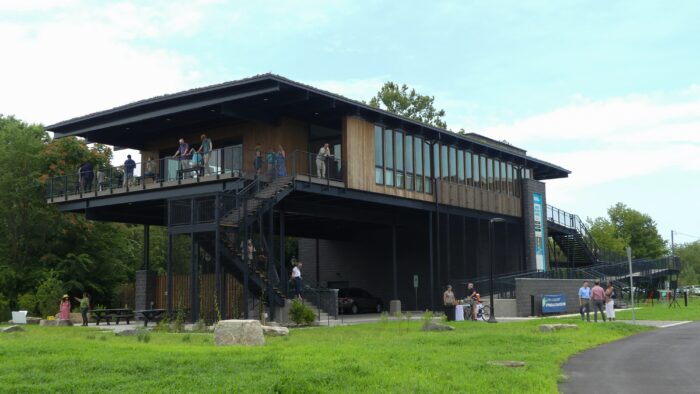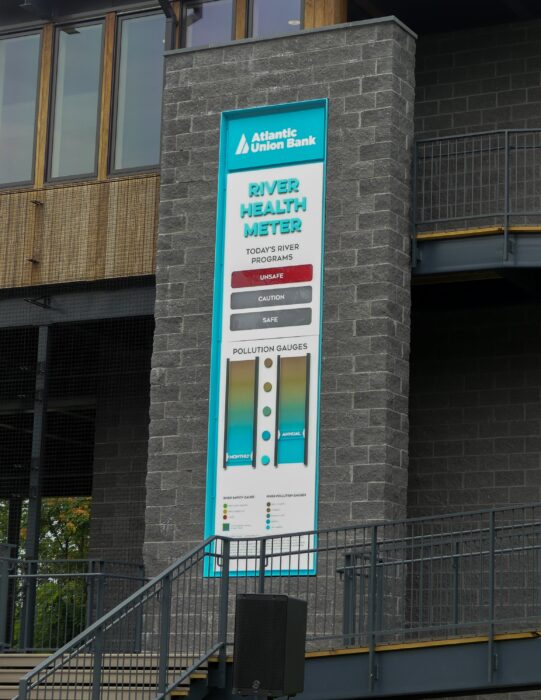The James River Association on Wednesday introduced the James A. Buzzard River Education Center, an 8,900-square-foot learning hub for local students that also offers increased public access to the river.
JRA President and CEO Bill Street said at an opening event that the center has an existing dock that allows access to tidal waters and is adjacent to roughly 10 acres of woods.
“Of all the sites we considered pursuing, this is by far the best site,” Street said at Wednesday’s event.
The center at 3021 Dock St. and is one of three James River centers run by the JRA. The others are in Lynchburg and Williamsburg.
It features outdoor classrooms, indoor classrooms dubbed the Shore Lab and the River Lab, a wrap-around deck and a gravel trail that leads to the dock behind the building.
The facility was built with awareness of potential threat of floods from the river and stormwater. The floor of the building stands 39 feet off the ground, built to weather 500-year flood and 100-year flood levels. The walls are constructed with paperless gypsum and the concrete floor is FEMA flood-damage resistant.
Eco-friendly measures include solar panels and a “green roof,” populated by succulents such as sedums to lessen rainwater runoff and help cool the building.
Visitors can judge whether the river is safe to enter based on a River Health Meter on the front of the building. The meter will display green if the river is safe, yellow if visitors should avoid direct contact with the water and red if it’s unsafe. The meter also features the river pollution levels for the month and the year.
“All of these design choices not only benefit the building and the James River, but also serve as a demonstration and education opportunity for the whole community,” Street said.
The center was designed by architecture firm 3North, Timmons Group served as the engineer and Kjellstrom + Lee served as the general contractor. The project cost $9 million, up from its initial projected cost because of a rise in construction costs.
In 2021 the JRA, the Capital Region Land Conservancy and the Conservation Fund bought 5 acres, 0.85 of which the center sits on. The groups bought the land for $4.87 million to place it under a conservation easement to block future development. The Conservation Fund transferred 4.33 acres to the city in May 2023 for $4.27 million to ensure public access.

Wednesday’s ribbon cutting included JRA’s Bill Street (center, black shirt), Mayor Levar Stoney, Sen. Tim Kaine and others.
The JRA operates the center and owns the parcel it sits on. The surrounding land and nearby dock belong to the city.
The land once had been proposed for a residential project called Echo Harbour.
The Virginia Capital Trail, which ran next to the property on Dock Street, was rerouted after the purchase.
Richmond Mayor Levar Stoney said at Wednesday’s event that the city will continue to protect the riverfront and provide equal access to the river.
“Kids who may not know much outside of the four blocks in which they live in will have an opportunity to learn about our greatest asset, the James River,” Stoney said.
The center is named in memory of Jim Buzzard, a former JRA board chairman. After his passing in 2021, Susan Snyder, Buzzard’s wife, doubled his donation to the James Changer Campaign, a $25 million fundraiser for James River centers.
The JRA started summer programming at the beginning of the month with Richmond Public Schools. Students from Chesterfield and Henrico counties will participate in center programming in the coming weeks.
“If you create passion among young people, then they’ll be stewards for life,” U.S. Sen. Tim Kaine said at the opening.
The James River Association on Wednesday introduced the James A. Buzzard River Education Center, an 8,900-square-foot learning hub for local students that also offers increased public access to the river.
JRA President and CEO Bill Street said at an opening event that the center has an existing dock that allows access to tidal waters and is adjacent to roughly 10 acres of woods.
“Of all the sites we considered pursuing, this is by far the best site,” Street said at Wednesday’s event.
The center at 3021 Dock St. and is one of three James River centers run by the JRA. The others are in Lynchburg and Williamsburg.
It features outdoor classrooms, indoor classrooms dubbed the Shore Lab and the River Lab, a wrap-around deck and a gravel trail that leads to the dock behind the building.
The facility was built with awareness of potential threat of floods from the river and stormwater. The floor of the building stands 39 feet off the ground, built to weather 500-year flood and 100-year flood levels. The walls are constructed with paperless gypsum and the concrete floor is FEMA flood-damage resistant.
Eco-friendly measures include solar panels and a “green roof,” populated by succulents such as sedums to lessen rainwater runoff and help cool the building.
Visitors can judge whether the river is safe to enter based on a River Health Meter on the front of the building. The meter will display green if the river is safe, yellow if visitors should avoid direct contact with the water and red if it’s unsafe. The meter also features the river pollution levels for the month and the year.
“All of these design choices not only benefit the building and the James River, but also serve as a demonstration and education opportunity for the whole community,” Street said.
The center was designed by architecture firm 3North, Timmons Group served as the engineer and Kjellstrom + Lee served as the general contractor. The project cost $9 million, up from its initial projected cost because of a rise in construction costs.
In 2021 the JRA, the Capital Region Land Conservancy and the Conservation Fund bought 5 acres, 0.85 of which the center sits on. The groups bought the land for $4.87 million to place it under a conservation easement to block future development. The Conservation Fund transferred 4.33 acres to the city in May 2023 for $4.27 million to ensure public access.

Wednesday’s ribbon cutting included JRA’s Bill Street (center, black shirt), Mayor Levar Stoney, Sen. Tim Kaine and others.
The JRA operates the center and owns the parcel it sits on. The surrounding land and nearby dock belong to the city.
The land once had been proposed for a residential project called Echo Harbour.
The Virginia Capital Trail, which ran next to the property on Dock Street, was rerouted after the purchase.
Richmond Mayor Levar Stoney said at Wednesday’s event that the city will continue to protect the riverfront and provide equal access to the river.
“Kids who may not know much outside of the four blocks in which they live in will have an opportunity to learn about our greatest asset, the James River,” Stoney said.
The center is named in memory of Jim Buzzard, a former JRA board chairman. After his passing in 2021, Susan Snyder, Buzzard’s wife, doubled his donation to the James Changer Campaign, a $25 million fundraiser for James River centers.
The JRA started summer programming at the beginning of the month with Richmond Public Schools. Students from Chesterfield and Henrico counties will participate in center programming in the coming weeks.
“If you create passion among young people, then they’ll be stewards for life,” U.S. Sen. Tim Kaine said at the opening.





You already know it is flashing red right now, wouldn’t be surprised if it was flashing red so much that the bulb goes out!
It was red because they were demonstrating the meter display.
I believe Walker is speaking metaphorically because of the current sewage spill in that area
Super cool. The James River Parks System is one of the things I’m most proud of about Richmond and it gets better and better every year.
This is such a great asset to have. Well done!
Great to see all the dignitaries onsite for the ribbon cutting.
Like they built it or something.
That’s gotta be 2.5millon for all the steel steps,rails,and landings
We are appreciative of the opportunity to be part of this project. Thank you to Kjellstrom+Lee for allowing us to partner with them on this project. http://www.BCLSLandscapeServices
No drop in visits allowed – Would be a great place for visitors, but alas this is RVA.